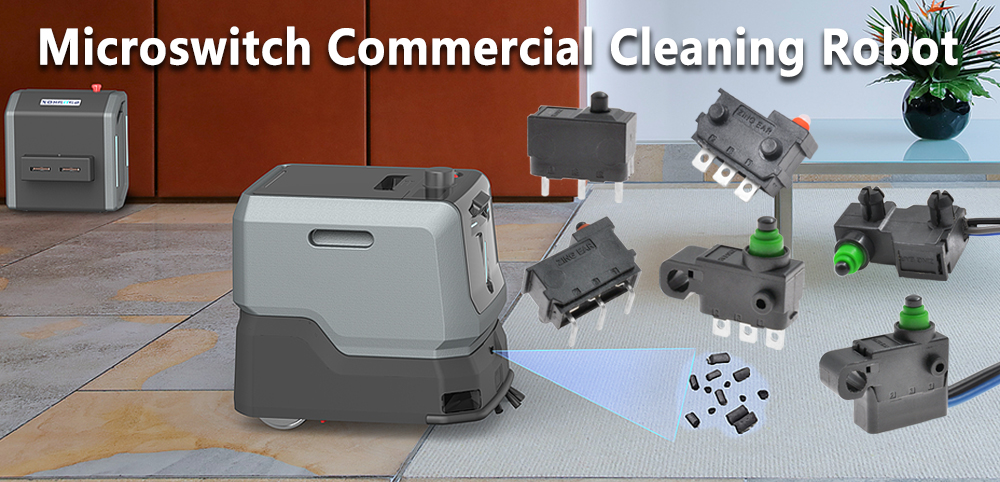G3 series microswitches can indeed play an important role in the functionality of commercial cleaning robots. These switches help with all aspects of robot performance, safety, and user interaction. A G3 series microswitch placed on the body of a commercial cleaning robot can act as a physical collision sensor. When a commercial cleaning robot comes into contact with an obstacle or furniture, these G3 series micro switches detect the impact force and signal the commercial cleaning robot to change its direction to avoid a collision.
A G3 series of tiny switches located near the edge of a commercial cleaning robot can help it detect when it is approaching stairs, steps, or ledges. This allows the commercial cleaning robot to adjust its path and avoid falling. The G3 series microswitches can be integrated into garbage bins or waste collection areas of commercial cleaning robots. They can detect when bins are full or properly in place, make sure commercial cleaning robots stop cleaning, or remind users to empty their bins.

G3 series microswitches contribute to the overall efficiency and safety of vacuum-sweeping robots by providing physical interaction and feedback mechanisms. Manufacturers design these switches to work seamlessly within the robotic system to enhance performance and user experience.
In a commercial cleaning robot, microswitches can serve various purposes to enhance the functionality, safety, and efficiency of the robot.
Microswitch method for commercial cleaning robots
Collision Avoidance
Microswitches can be strategically placed on the robot’s body to act as collision sensors. When the robot makes contact with an obstacle or object, the microswitches detect the impact and signal the robot to change its direction or stop to prevent damage.
Docking and Charging
Microswitches can be used to ensure precise docking of the robot onto its charging station. The robot’s docking mechanism might use microswitches to confirm that it’s properly aligned with the charging contacts.
Cleaning Path Detection
Microswitches can be utilized to determine if specific areas have been cleaned. For example, when a robot uses a mop or scrubber attachment, microswitches could detect whether the cleaning attachment has made contact with the floor.
Stair and Edge Detection
Microswitches placed near the edges of the robot can help it detect when it’s about to approach stairs or ledges, allowing the robot to change direction and avoid falling.
Obstacle Detection
In addition to collision avoidance, microswitches can detect smaller obstacles that might not be detected by other sensors, helping the robot navigate around cluttered areas effectively.
User Interaction
Microswitches can be used for user-initiated actions, such as starting or stopping the cleaning process, changing cleaning modes, or activating specific functions.
Safety Shutdown
In the event of a malfunction or unsafe condition, microswitches can serve as emergency shutdown triggers to stop the robot’s operation and prevent potential hazards.
Attachment Detection
If the cleaning robot has interchangeable attachments, microswitches can ensure that attachments are properly secured before the robot operates.
The exact placement and function of microswitches in a commercial cleaning robot would depend on the robot’s design, the cleaning tasks it performs, and the desired safety and functionality features. Manufacturers typically engineer these components to work seamlessly within the robot’s system, enhancing its overall performance and user experience.
G3 series micro switch application
A G3 subminiature-sealed microswitch is a type of microswitch that is designed to be compact and protected from environmental factors such as dust, moisture, and other contaminants. Microswitches are small, sensitive switches that are actuated by minimal physical force. They are commonly used in various applications for detecting position, movement, or pressure.
The term “subminiature” indicates that these micro switches are even smaller than standard micro switches, making them suitable for applications where space is limited. The “sealed” aspect of these switches implies that they are enclosed or protected in a way that prevents external elements from affecting their performance. This sealing might involve using gaskets, seals, or coatings to make the switch more resistant to dust, water, or other environmental conditions.
Subminiature sealed micro switches find application in a wide range of industries and devices, including consumer electronics, automotive systems, industrial equipment, medical devices, and more. They are often chosen for their durability, reliability, and ability to function in challenging environments.
How is the micro switch on the sweeping robot designed?
The design of the G3 series microswitches in commercial cleaning robots may vary by manufacturer, model, and specific use case. However, G3 Series microswitches are strategically placed on the chassis or body of commercial cleaning robots so that they can contact objects or surfaces. They could be placed in areas where collisions are likely, near the edges of commercial cleaning robots to detect stairs or ledges, and in litter box areas to sense when a litter box is full.
G3 Series micro switches are activated by physical pressure or motion. When a certain amount of force or displacement is applied to the switch, it triggers an electrical signal. A typical microswitch design consists of a small button or lever that is pressed or moved when external force is applied. When a button or lever is pressed, it forms an electrical circuit that sends a signal to the control system of a commercial cleaning robot.
G3 series micro switches are usually mounted with screws or clamps. They are rigidly attached to the frame of commercial cleaning robots to ensure accurate and consistent detection of various conditions. The microswitch is connected to the electric control system of the commercial cleaning robot through wiring. When a G3 series microswitch is activated, it sends an electrical signal to the control unit, which processes the signal and determines the appropriate action.
